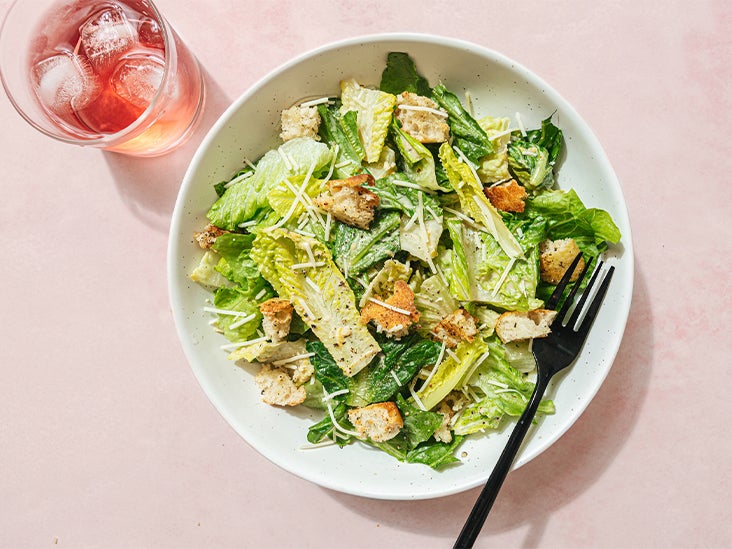If you’ve bitten into a Caesar salad, you know it’s delicious and popular, but you may be wondering if it’s good for you. Even though it’s a salad, it does come with creamy dressing, cheese, and croutons.
In this article, we take a closer look at this beloved dish and provide more information about what Caesar salad is, what its nutrition profile looks like, and how to make it healthier.
Caesar salad’s origins are a bit of a question mark. While there’s some uncertainty around who invented the famous salad, we know the basic elements.
The salad typically includes romaine lettuce, croutons, Parmesan cheese, and a dressing made of anchovies, olive oil, garlic, lemon, egg yolks, and Dijon mustard.
But not all Caesar salads are created equal in today’s creative culinary world. Chefs and home cooks have been experimenting with the recipe, reinventing it in ways to simplify the process and in some cases, make it more nutritious.
Sometimes you’ll see kale and other lettuces used alongside or instead of romaine, or you’ll find croutons made from cornbread or a whole-grain ciabatta. You also might find additions, such as avocado, tomatoes, and bell peppers.
Caesar salad is often served with a protein source like grilled chicken, blackened salmon, nuts, or sautéed tofu.
While the nutritional composition will vary based on the ingredients and dressing used, a prepackaged 100-gram serving (about 1 1/4 cups) of Caesar salad provides (1, 2, 3, 4, 5):
Traditional Caesar salads can be high in saturated fat, thanks to the dressing and cheese. Salads that use “light” dressing are lower comparatively, but can still be high in sodium.
Making your own dressing is also an option, and it allows you to choose your own ingredients and flavors.
Caesar salad is typically served with its own dressing, which is called Caesar dressing. It’s made from anchovies, garlic, egg yolks, lemon juice, Dijon mustard, oil, salt and Parmesan cheese.
Several varieties of Caesar dressing are available, including regular, light, and fat-free. You can also find vegan dressings that are made with avocado oil or other plant-based oils instead of eggs. Homemade dressing is also an option.
Here are the nutritional profiles of 2 tablespoons (about 30 grams) of 3 types of Caesar dressing (4, 6, 7):

Go heavy on the veggies
Yes, traditional Caesar salad only contains one vegetable: romaine lettuce. However, it’s your salad, so you can build it how you want.
Most vegetables taste great with it, such as tomatoes, baby lettuces, cucumbers, and radishes.
Those veggies are packed with vitamins, minerals, fiber, and other nutrients your body needs. At the same time, they’re low in calories, which means they’re considered nutrient-dense (15).
Make your salad at home or adjust pre-made versions
Prepackaged salad kits make creating salads at home simple, but consider making a modification or two:
- cutting back on dressing provided or mixing it with Greek yogurt to add protein
- replacing croutons with a more nutrient-dense crunchy topping, such as nuts or seeds
- buying a bag of mixed greens or other veggies to pair with it
12 Mistakes That Are Making Your Healthy Salad Unhealthy
Why is Ceaser salad bad for You?
The dressing is one of the most important parts of a Ceaser salad. It’s what gives it flavor and makes it taste like a Caesar salad. The problem is that many restaurants use salad dressings that are made from high fructose corn syrup, which can be bad for your body. 2. Because It’s A Fast Food Item.
Is it safe to consume a sugar free salad dressing containing sucralose?
Sucralose is one of the top artificial sweeteners, and it is marketed as a healthy alternative. Although, sucralose can provoke many side effects; it may cause diabetes, increases the risk of irritable bowel syndrome and Crohn’s disease, is linked to leaky gut, may generate toxic and carcinogenic compounds when heated, and it is associated with weight gain. So, it is not a healthy option, to consume frequently a sugar-free salad dressing containing sucralose.
Is a Caesar salad healthy?
A classic Caesar salad can fit into any healthy eating plan, but modifications to make it more nutritious may be a good idea if you eat them often. Choose a salad dressing that’s low in saturated fat and sodium and consider using a 1-tablespoon (14-gram) serving.
Why should you eat a Ceaser salad?
Protein is necessary for a healthy body and is often a macronutrient that people don’t get enough of. Protein is critical for building muscle, regulating metabolism, keeping you full longer, and even helping you maintain healthy blood pressure. Fortunately, adding a source of protein to your Ceaser salad is easy.
